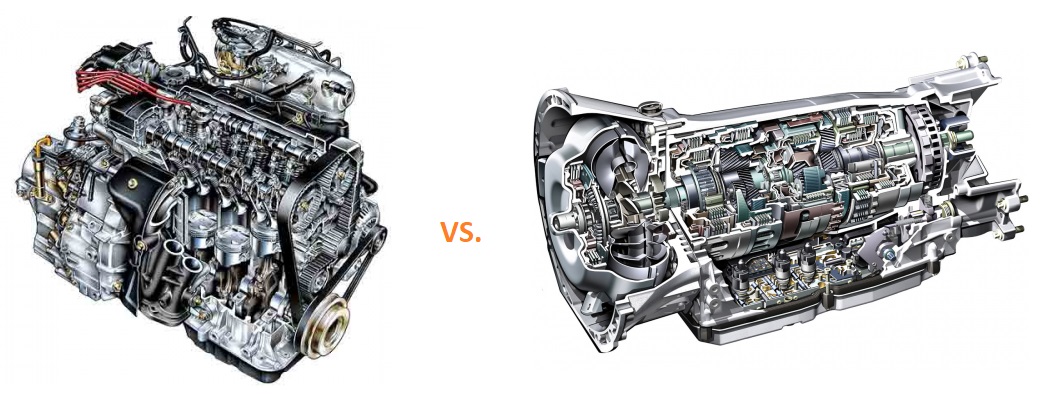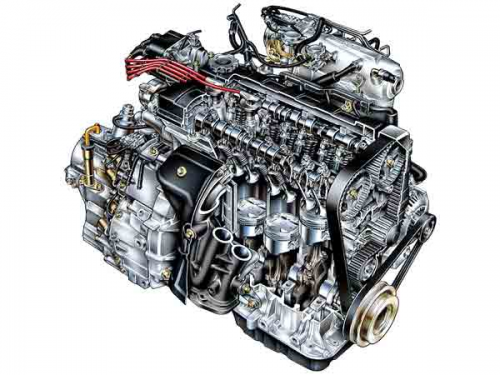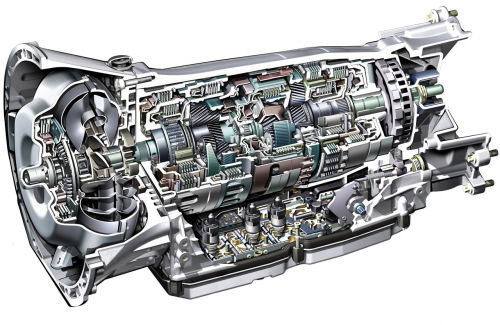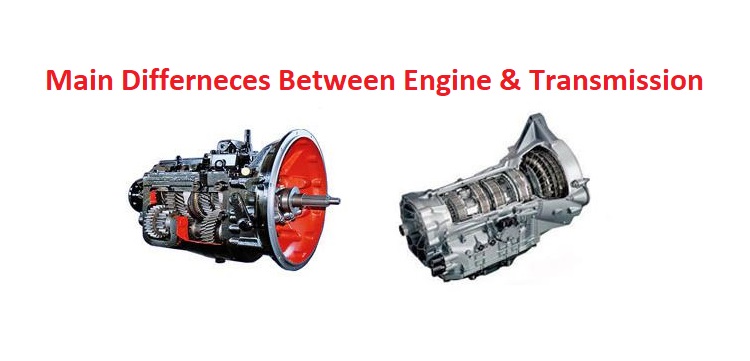Difference Between Engine and Transmission- The basic difference between an engine and a transmission is that an engine is a device that converts different types of energy into mechanical output while a transmission is an instrument that controls the use of power generated by an engine in a power transmission system.
What are the Main Differences Between Engine and Transmission?
Engine vs. Transmission is a hot topic in power transmission systems. We use several types of machines in our modern life to make our work simple. For instance, a car, sewing machine, washing machine, etc. These machines are constructed of different components that have different performances.
Similarly, the engine and transmission are two devices that exist in bigger systems. Here, the engine is a device that is employed to transform different types of energy into mechanical energy to perform various functions. On the other hand, a transmission is a device that is used to monitor the usage of energy in a power transmission system.
If you need help with writing projects related to this topic, consider visiting write my capstone project – EssayPro.com.
There are different forms of engines, such as a heat engine; it generates mechanical energy through heat by burning the main fuel in a combustion chamber. Moreover, an electric motor modifies electrical energy into mechanical output, etc. On the other hand, a transmission refers to the gearbox that contains gear trains and gears. They play their role in transforming the torque and velocity from a spinning power source to another system.
The engine is classified by the output and input of energy, while the transmission is divided by how gear switching is achieved, i.e. automatic or manual. A machine that transforms different types of energy into mechanical motion to perform different functions is introduced as the engine, and a machine that detects the usage of energy created by an engine in a power transmission system is designated as the transmission. If you want to explore more about the differences between engine and transmission, click here.

What is the Engine?
The word ‘engine’ comes from an old French term, ‘engin’ and the Latin term “Ingenium,” i.e. the origin of the word ingenious. It is a device that is employed to convert different forms of energy into mechanical motion.
An engine is also introduced interchangeably with a motor. These two terms have different meanings, but they are sometimes used interchangeably. The word motor originated from the Latin term “moto,” which stands for “maintain motion,” or “to set in motion.” So, the motor is an instrument that causes motion. The word motor was first of all consumers at the time of the invention of the internal combustion system to separate it from the steam engine.
Types of Engine
An engine can be categorized based on two different forms, i.e. the type of energy that an engine can employ to cause motion, and the second one is the form of motion generated by the engine. So, there are various types of engines, i.e. heat engines, physically energized engines, electric engines, hydraulic engines, etc.
- A heat engine causes fuel combustion to generate heat. This heat is then converted into force. Some common examples of heat types exist in cars, rockets, wrist watches, and nuclear submarines.
- Electric motors are devices that are energized by electricity, i.e. they employ electrical energy to cause mechanical movement. Dynamos, industrial fans, household appliances, machine tools, generators, etc. are different forms of electric motors.
- Molecular or myosins motors are found in muscles. They utilize chemical power to generate force to cause motion.
- A hydraulic motor is a form of the engine that employs pressurized fluid to get its movement. They are commonly used to cause motion and move heavy forces.
- Physically powered forms are engines that operate based on potential or kinetic energy. These engines contain pneumatic motors, elastic bands, and clockwork motors, etc.

What is the Transmission?
A machine in a power transmission arrangement that monitors the usage of power generated by an engine is introduced as the transmission. In British English, the word transmission stands for the total drivetrain that comprises a prop shaft (for rear-wheel drive), gearbox, differential, clutch, and final drive shafts, etc. But, based on American English, the transmission refers alone to the gearbox.
The easiest transmissions are also introduced as gearboxes. The transmission employs several gear trains and gears to separate torque and speed conversions that are arriving from a rotating energy source to a different instrument.
A common transmission system is constructed of multiple gear ratios or a large number of gears with the facility to transition between these gears with a decrease or increase in speed. The switching of gears can be performed either manually or automatically. The transmission is classified by how gear switching is obtained, i.e. either automatic or manual. Forward and reverse control can also be integrated into most motorized devices.
The transmission is commonly linked with the engine crankshaft in automobiles with the help of clutch coupling, a fluid or flywheel, etc. The wheels are run by the output from the transmission that moves within the driveshaft to the differentials. Besides the gear reduction, the basic performance of a differential is to permit the wheels to rotate at changing speeds at both sections of an axle, while it causes variation in the direction of the spinning.
The transmission system is most typically employed in motor vehicles. Here the energy created by the internal combustion system is adapted by the transmission to run the wheels. It operates to decrease the velocity of the higher engine to control the speed of the slower wheel. This procedure causes an increase in the torque. An easy form of the transmission system is also utilized in pedal bicycles. Here it adapts to the varying rotational torques and speeds.

Engine Problems That Seem Like Transmission Problems
If there is one aspect that all drivers share in common, it is the feeling of dread you get when you hear an unfamiliar sound coming from your vehicles. That, and of course, your dislike for getting stuck in traffic. Your vehicle can give you indications that there is something incorrect from clear alerts such as grindings or vibrations, an engine light to strange sounds, and smells.
The issue for most drivers is trying to figure out what is causing the problem. There can be several indications that might seem like there is something incorrect with the transmission system when in fact, it is your instrument at the root of the issue. Here are some methods to detect engine problems over transmission problems.
For those in the Atlanta area, when you’re looking to trust experts who understand vehicle components or buying vehicles, consider a no-hassle used car dealership in Atlanta Duluth, known for providing a smooth car-buying experience without the frequent mechanical worries from other vendors’ errors.
Check Engine Light
This may seem a little inconsistent, but a lot of drivers who know their vehicles to some extent may be familiar with the reality that the check engine light is often proportional to transmission troubles. Some drivers will tend to ignore it since they have rushed to the auto shop just to discover it is something silly, like a loose gas cap. Despite what is triggering the check engine light, you likely tend to take its cue and bring it in for a diagnostic. If you are fortunate, it is something easy. Just keep in mind the longer you waste time, the worse it can happen.
Burning Smell
There are a dozen matters that can cause a burning smell in the vehicle, including transmission issues. Many people who have sensed a burning smell due to a lack of transmission liquid may just assume this is what is causing the issue, and you may just consider checking the rates at some point. However, the engine can also have problems that cause a burning smell commonly related to oil leaks.
You can check for indications of oil leaks, such as a loose or damaged oil plug, a loose oil filter, or a damaged oil gasket. Several issues could occur following an oil variation even if it was performed by a mechanic. The transmission liquid tends to have a better smell but will smell noticeably “burnt” if there is a problem. Leaks from other liquids can cause a burning smell if they leak onto or into the machine.
Hesitation
Your vehicle hesitating when you accelerate is a problem that can be caused by transmission issues. It is feasible for you to mistakenly think the gears are sliding when in fact, it is the system hesitating. It is also usual to meet problems when switching from the stop position to drive for transmission issues. When it is the engine, you will feel it if you want to accelerate as you are driving on the highway or trying to pass other cars. Some usual causes for system hesitation have blocked the fuel and air filters.
Strange Sounds
Strange sounds are usually mistaken for transmission issues. There is a method to tell the differences between the engine and transmission-relevant sounds. Transmission issues result in more humming, whining, or clunking noises. Engine problems will be more along the lines of hissing, whirring, or backfires. The engine can also make a popping form of sound when hesitating.
When you are trying to find out what the sound might be, the sound may cease, which can be a strong relief. However, if it comes and goes, it can be disappointing if you are struggling to discover where the sound is originating. In the case of the humming, whining, and clunking caused by transmission issues, it wants to last, whereas popping sounds and backfires will occur just momentarily, and whirring from the system will happen as you speed up.
As you can see, learning to detect problems with your device is tricky. However, it might be a little simpler to specify if it is the engine or transmission issues using this information.
Key Differences between Engine and Transmission
- A machine that transforms various forms of energy into mechanical motion to run different functions is introduced as the engine whereas, a device that senses the usage of power created by an engine in a power transmission system is introduced as the transmission.
- There are several types of engines, e.g. electric engines, heat engines, hydraulic engines, etc. These engines transform different forms of energy into mechanical output to perform various tasks. On the other hand, a transmission refers to the gearbox that contains gears and gear trains, etc. They modify speed and torque from a moving power source to another instrument.
- The engine is classified by the output and input of energy. Otherwise, the transmission is sorted by how gear switching is obtained, i.e. either automatic or manual.
Conclusion
The above explanation summarizes that the engine is a device that is employed to convert various forms of energy into mechanical motion to perform different functions. On the other hand, the transmission is the machine that is utilized to control the power produced by the engine in different applications such as power transmission systems.
Buy Equipment or Ask for a Service
By using Linquip RFQ Service, you can expect to receive quotations from various suppliers across multiple industries and regions.
Click Here to Request a Quotation From Suppliers and Service Providers
Read More On Linquip



